Highlight Editing Tutorial: Step-by-Step Guide for Eye-Catching Reels
Updated On: August 23, 2025 by Aaron Connolly
Understanding Highlight Editing Basics
Highlight editing means picking out the best bits from a long video and turning them into a short, punchy reel. I’ll show you what makes a highlight video work, where people use them, and how to spot the moments that’ll actually keep folks watching.
What Is a Highlight Video?
A highlight video is just a short mashup of the top moments from a longer recording. Usually, these run anywhere from 30 seconds up to 5 minutes.
The goal? Grab attention fast. People decide in the first few seconds if they’re going to stick around or swipe away.
What makes highlight videos pop?
- Fast edits and smooth transitions
- A killer opening shot
- Good sound and crisp visuals
- Clips that flow naturally
- Upbeat music that fits the vibe
Highlight reels work because they cut out all the boring bits. Instead of slogging through half an hour, viewers just get the best parts.
You’ll trim clips, add transitions, and sync everything to the beat. This rhythm is what keeps people glued to the screen.
Popular Uses for Highlight Videos
Sports teams love highlight reels for showing off players and epic games. They use these for recruiting and getting fans hyped on social media.
Content creators chop up their streams or game sessions into highlight reels. That way, fans get a quick hit of the best stuff, and new people might actually give them a shot.
Businesses turn conferences or launches into highlight videos too. These work for marketing or sharing with the team later.
| Use Case | Typical Length | Main Purpose |
|---|---|---|
| Sports highlights | 2-5 minutes | Show best plays |
| Gaming content | 1-3 minutes | Entertaining moments |
| Event coverage | 3-8 minutes | Event summary |
| Social media | 15-60 seconds | Quick engagement |
Wedding videographers and event photographers offer highlight reels as a special extra. Couples get a quick film packed with the day’s best moments.
Apps like TikTok and Instagram Reels have made these short highlight clips blow up even more.
Choosing the Right Moments
Kick off with high-energy moments that grab people right away. That first clip sets the mood, so pick something that hooks viewers instantly.
Search for emotional high points in your footage. Celebrations, wild reactions, or dramatic twists always land well.
Don’t repeat yourself—even if each moment feels cool on its own. If you show three of the same type of goal or reaction, people will tune out.
Here’s a quick tip: Watch your footage and jot down times where you actually feel something. Those are usually your best highlights.
Think about your audience when you pick clips. Gamers want a different pace than folks watching a wedding or a business event.
Quality matters. If a clip has bad sound, shaky camera, or terrible lighting, skip it unless it’s truly can’t-miss.
Try to build a little story, even if your video’s short. Start strong, mix it up in the middle, and finish with a big moment.
Mix up your pacing. Throw in some quick cuts, but don’t shy away from a longer shot if it’s a showstopper. All fast cuts can get exhausting, but too many slow moments will lose people.
Planning Your Highlight Video Project
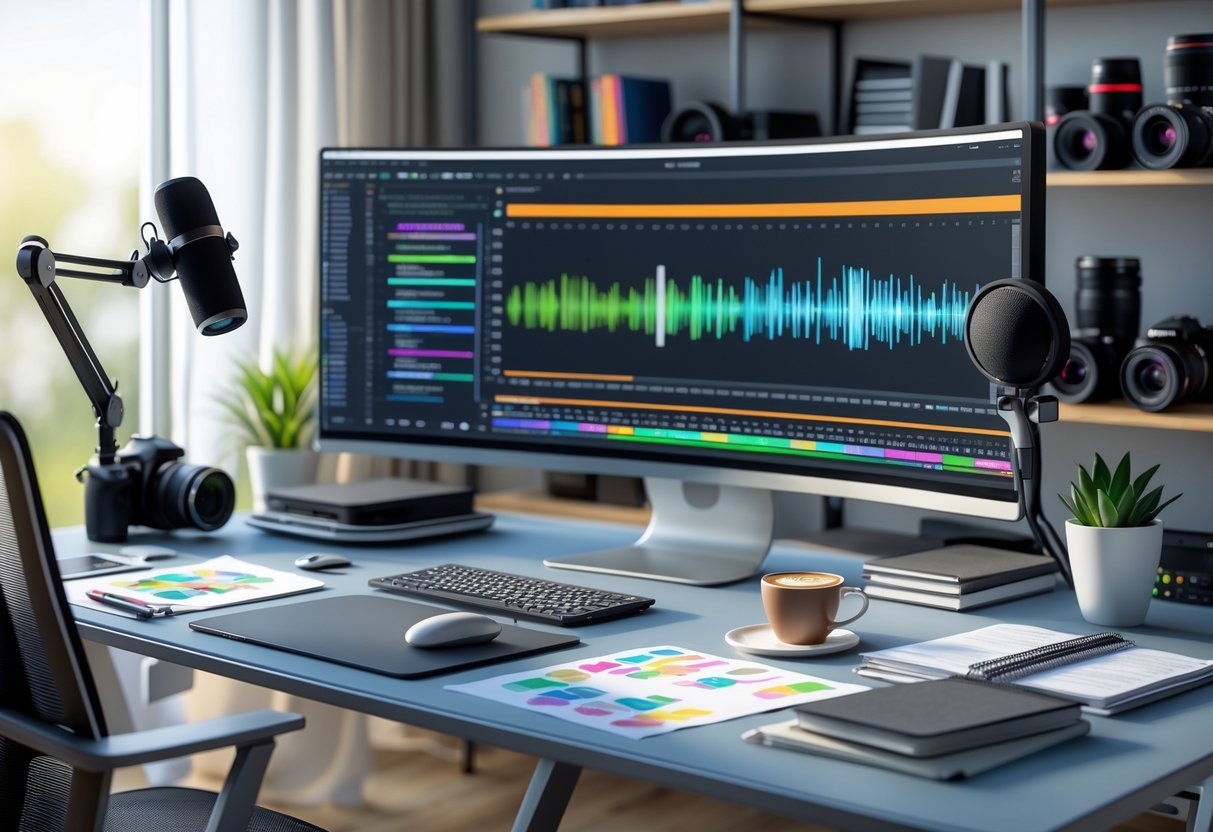
Good planning separates a messy clip dump from a highlight reel that actually works. Let’s talk about figuring out your purpose, knowing your audience, sketching out a plan, and getting your files in order.
Defining Your Purpose and Audience
Before you start cutting, you need to know why you’re making this video. Are you trying to get sponsors with tournament highlights? Maybe you want match recaps for your team’s socials? Or a player montage for recruiting?
Each purpose needs its own approach. Sponsor reels should show off crowd energy and branding. Recruitment highlights need skill plays and clutch moments. Social media reels? Keep ‘em short and snappy.
Your audience changes everything. Gamers want technical plays and meta moments. Sports fans might want more context and big reactions.
Quick tip: Write down—literally, with a pen—your video’s main goal in one sentence. Keep it handy. It’ll help you make tough choices later.
Think about where you’ll post it, too. YouTube highlights can stretch to 3-5 minutes. Instagram Reels? 30-60 seconds, max. TikTok? Under 30 seconds, and you need a hook right away.
Storyboarding and Shot Lists
Sketch out your highlight’s structure before you even open your editor. Think of it as your video’s game plan.
Use a basic three-part structure:
- Opening: Start with your best shot
- Middle: Build up with key plays and reactions
- Closing: End with a bang or an emotional finish
Make a shot list of the moments you want. Note the time and why each clip matters. This saves you from digging through hours of footage later.
For esports, don’t forget these:
- Game-winning plays
- Player reactions
- Crowd shots (if you have them)
- Skill displays
- Teamwork moments
Don’t cram in everything. Five awesome clips always beat fifteen “meh” ones.
Arrange your shots to keep the energy up and down—don’t just stack all the action together. Give people a breather now and then.
Organising Video Clips
Setting up your files right makes editing so much easier. I always make folders before I start.
Try this setup:
Project Name/
├── Raw Footage/
├── Audio/
├── Graphics/
├── Exports/
└── Project Files/Name your clips so you know what’s what. “clutch_ace_round15” is way better than “clip001.” Add player names or round numbers if it helps.
Watch all your footage first and mark the best bits. Most editors let you throw in markers or rate clips. That first pass saves you from missing hidden gems.
I like to keep a spreadsheet with:
- Clip name
- How long it is
- Quality (1-5)
- Short description
- Where you’ll use it
Bring everything into your editor in groups. Keep similar stuff together—player cams in one spot, game footage in another.
Seriously, spend half an hour getting organised now. It’ll save you hours later.
Capturing Footage for Highlights
If you want your highlight video to stand out, you need good footage—plain and simple. The right gear, multiple camera angles, and solid audio recording can turn amateur clips into something that looks pro.
Equipment Selection and Setup
Camera choice isn’t all about price. Even a new-ish smartphone can shoot sharp 1080p at 60fps, which works for most highlights. For sports, go for higher frame rates—60fps makes sweet slow-motion, way better than 30fps.
Set up your main camera where the action happens. For football, that’s usually midfield and up high. For gaming events, point it at the stage so you catch player reactions.
Use a tripod or gimbal to keep things steady. Even a little shake can ruin an epic moment. If you’re using a phone, turn on stabilisation in the settings.
Charge everything and bring extra memory. You never know when a highlight will happen, and you don’t want to miss it because your battery died.
Filming Multiple Angles
Go wide for context and close for emotion. Your main camera should get the big picture, but a second angle—maybe on the players or the crowd—adds a pro touch.
Switch up your shots. Shoot some wide venue shots, medium plays, and tight close-ups. Variety gives you options when you edit.
Moving shots can look awesome, but only if you’ve practiced. Honestly, shaky cam is worse than just sticking with a tripod.
If you’re not the only one filming, talk to the others. Coordinate so you don’t block each other, and maybe swap footage later.
Recording High-Quality Audio
Built-in mics almost never cut it. Crowd noise, wind, and distance mess up your sound. Even a cheap external mic makes a big difference.
Aim your mic at the action. Directional mics beat omnidirectional ones in noisy spots. Try to avoid pointing at speakers or fans.
Record separate audio if you can. Wireless mics for interviews or commentary work great, and you can sync them with your video later.
Keep an eye on your audio levels. Most cameras show you meters—shoot for -12dB to -6dB. Too quiet is better than too loud, because you can always boost it in post.
Importing and Preparing Video Clips
Getting your footage organised from the start makes editing so much easier. I’ll walk through collecting all your clips, pulling them into your editing software, and building that first rough cut.
Collecting Footage
Before you touch your editor, gather all your video clips in one spot. Dig up every file from cameras, phones, and recorders.
Make a folder on your computer just for this project. Call it something obvious, like “Tournament_Highlights_Jan2025,” so you don’t lose it.
Copy all your files into this folder. Don’t move them—copy them. That way, your originals are safe if anything goes sideways.
Sort your clips by:
- When you recorded them
- What camera or device you used
- Best moments vs. background filler
Write down your favorite moments while the event’s still fresh. Jot down times or notes like “crazy save at 2:15” or “goal celebration.”
Double-check that all your files play. It’s a pain to discover a broken file when you’re halfway done editing.
Importing to Editing Software
Now, bring your sorted footage into your editing app. Whether it’s Clipchamp, CapCut, or Premiere Pro, the basics are pretty similar.
Open your editor and start a new project. Use the same name as your folder to keep things tidy.
To import:
- Click “Import” or “Add Media”
- Find your project folder
- Select all your files (hold Ctrl or Cmd)
- Hit “Import” or drag them onto the timeline
Some editors let you preview as you import. Take advantage—mark your favorites right away.
Import everything, even if you’re not sure you’ll use it. Better too much than missing that one clip you need.
Set up folders or bins in your editor that match your file setup. It keeps things from getting out of hand as your project grows.
Creating the Rough Cut
Think of your rough cut as a first draft—it just needs to work, not win awards. This is where you map out the basic structure of your highlight video.
Fire up your editing software and watch all your footage again. Mark the absolute best moments with notes or markers as you go.
Build your rough cut by:
- Dragging your top 10-15 moments onto the timeline
- Arranging them in chronological order or by excitement level
- Trimming obvious dead time from the start and end of each clip
Skip the precise cuts or fancy transitions for now. You just want the key moments lined up in a way that’s watchable.
Let your rough cut run a bit long. If you want a 3-minute highlight, aim for 5-6 minutes in the rough cut. It’s easier to trim than to add later.
Watch the whole thing from start to finish. Does it tell the story you want? Are your biggest moments spaced out, or do they clump together? Now’s the time to shuffle things around before you get attached.
Save your project often. Sure, most editing software auto-saves, but hitting save yourself can save a headache during long sessions.
Selecting and Refining Key Moments
The best highlight videos always come down to picking the right moments and shaping them into something compelling. You want to spot scenes that really pop, cut out the dull stuff, and arrange clips so viewers stay hooked.
Identifying Standout Scenes
Start by figuring out what makes a moment stand out. Look for peak action—scoring plays, dramatic saves, or those clutch moves under real pressure.
Don’t ignore the emotional side. Celebrations, intense focus, or wild crowd reactions can hit just as hard as the action.
Key elements to watch for:
- Turning points—moments that shift the game’s momentum
- Technical skill—crazy mechanical plays or smart decisions
- High-stakes situations—final rounds, overtime, or championship points
- Player interactions—team celebrations, handshakes, coaching moments
Watch your footage at normal speed at least once. If you just scrub through the timeline, you’ll probably miss the natural flow of the best moments.
Drop markers or jot down notes as you go. Most editing apps let you flag highlights right on the timeline, which is super handy.
Trimming and Splitting Clips
Once you’ve got your standout scenes, trim them down to just the essential action. Start your cut a bit before the action hits to build anticipation, then let it run a little past the peak.
For effective trimming:
- Cut out boring setup but leave enough context
- Let big moments breathe—don’t rush the emotion
- Kill dead air between plays or rounds
- Keep authentic audio reactions if you can
Split longer clips into multiple pieces when it makes sense. That way you can use different angles or break up a single play.
Let your most dramatic moments run 8-10 seconds if they deserve it. Transitional clips usually work better at 3-4 seconds.
Editing software usually lets you trim frame by frame. Use that so you get the timing just right, not just “close enough.”
Sequencing for Flow
Arrange your trimmed clips so the energy feels right. Kick things off with a strong hook—your second or third-best moment often works better than saving everything for the finale.
Mix up the pacing. Follow a wild action clip with a quick reaction or setup shot to keep things fresh.
Sequencing strategies:
- Chronological—stick to the actual event order
- Escalating intensity—ramp up from good to jaw-dropping
- Thematic grouping—cluster similar plays together
- Peak-valley rhythm—alternate big moments with slower ones
Put your best stuff up front, especially in the first 30 seconds. Hit viewers again with something strong near the end.
Try out different orders by watching your rough cut a few times. If something drags or feels off, that’s your cue to tighten it up.
Essential Video Editing Techniques
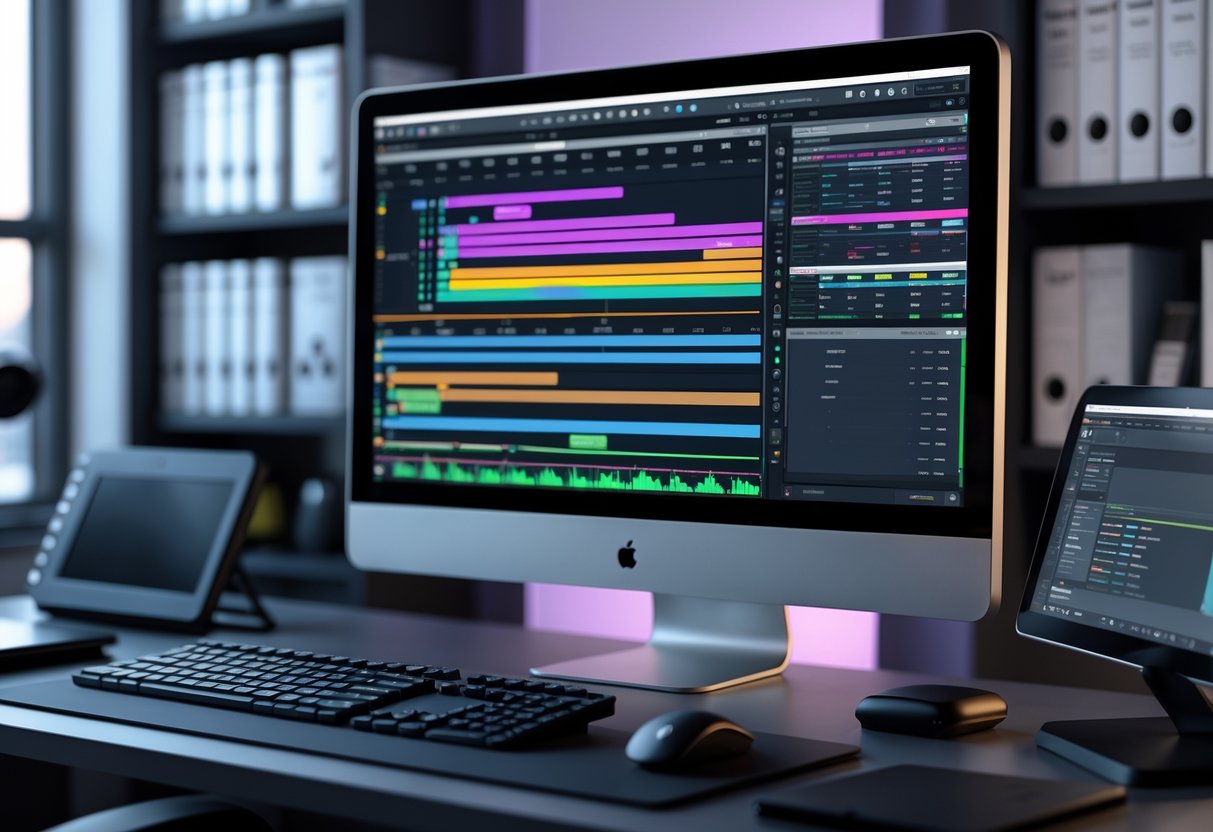
Smooth transitions keep people watching by connecting clips seamlessly. Speed effects like slow motion can make your best moments really stand out.
Applying Smooth Transitions
Smooth transitions are the secret sauce in pro highlight videos. They bridge clips without any awkward jumps that snap viewers out of the moment.
Use cross dissolves for emotional scenes. They blend clips together gently, which works great when you’re building atmosphere.
For fast-paced action, stick with cut transitions. Hard cuts keep the energy up and make sequences feel punchy.
Most editing software comes loaded with transition libraries. DaVinci Resolve gives you pro options for free, and Premiere Pro has a ton of presets.
Don’t overdo it. Keep transitions short—around half a second to a second. Longer fades just slow things down and can feel clunky.
Match your transition style to the mood. Subtle fades fit reflective moments, while quick cuts are perfect for high-energy highlights.
Using Slow Motion and Speed Effects
Slow motion can turn an average play into something epic. It spotlights skill and makes key plays feel bigger.
Try slowing footage to 50% for drama. That’s usually smooth enough without looking choppy. If you dip below 25%, things can start to drag.
Speed ramping mixes normal and slow speeds in one clip. Start at regular speed, slow down for the big moment, then ramp back up. It’s a cool way to highlight peak action.
Editing apps usually have speed controls right in the timeline. Right-click the clip and adjust. Premiere Pro even has optical flow for extra smooth slow-mo.
Quick tip: Shoot at higher frame rates (like 60 or 120fps) if you can. That way, slow motion stays crisp.
Don’t go wild with slow motion—save it for your best, most impactful moments. Otherwise, it just loses its punch.
Enhancing with Music and Sound Effects
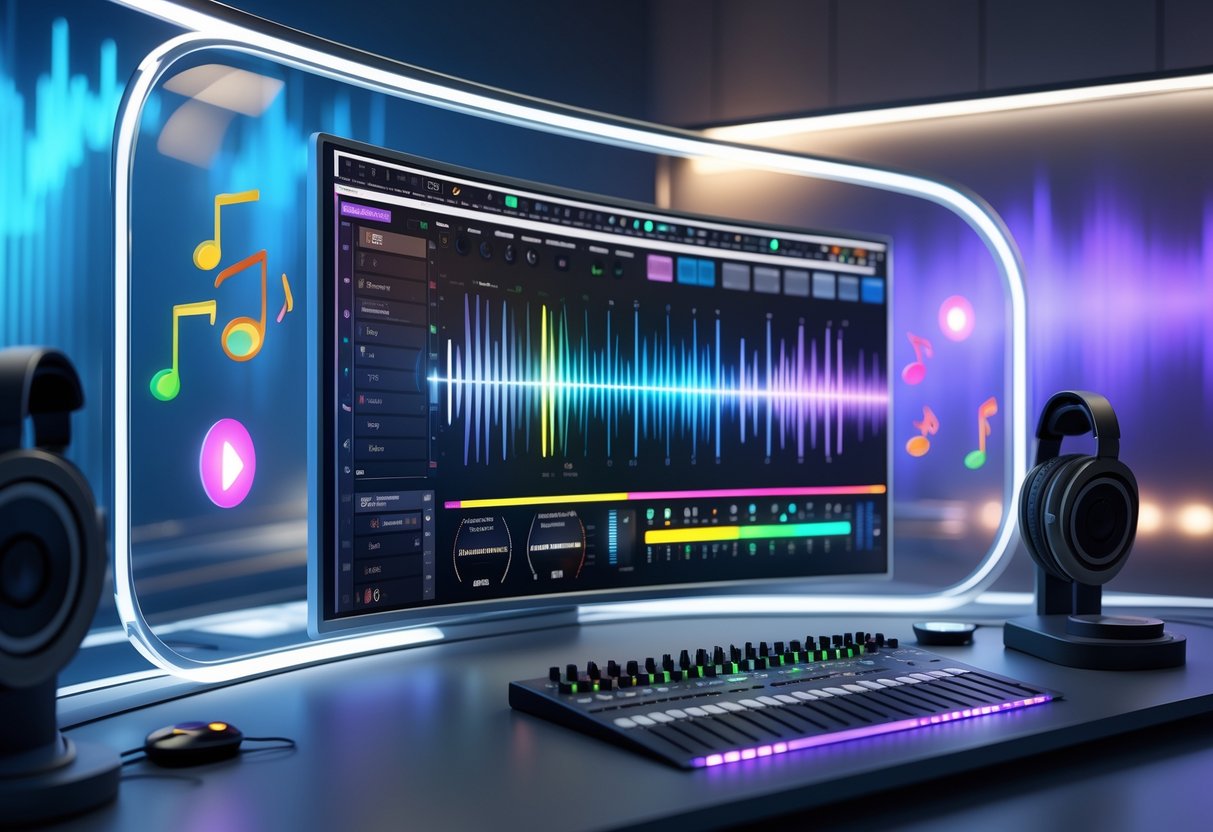
Good audio can turn a basic highlight reel into something people actually want to watch. The right background music sets the mood, and sound effects make big moments hit harder.
Choosing Background Music
Music changes how viewers feel about your video. Upbeat electronic tracks fit fast-paced gaming, while mellow instrumentals work for slower or more emotional scenes.
Try to match the music’s energy to your gameplay. High-action moments—like clutch plays—pair well with energetic tracks. Slower highlights or thoughtful plays need something more chill, like ambient or orchestral tunes.
Think about your audience. EDM usually appeals to younger gamers, but rock or cinematic scores might click with a broader crowd. Fast edits need fast music, while longer shots can handle a slower beat.
Keep the music volume balanced so you don’t drown out the game audio. You want the music to boost the mood, not take over.
Adding Royalty-Free Music
Copyrighted music can get your videos taken down or flagged on YouTube and Twitch. Royalty-free libraries fix that by giving you tracks you can actually use.
Try YouTube Audio Library, Epidemic Sound, or Artlist. They’ve got tracks in every genre, and the licensing is usually clear.
Most high-quality audio libraries let you search by mood, genre, or tempo. Filter to find something that fits your video’s vibe and length. Subscriptions usually run £10-30 a month for full access.
Always grab the best quality you can—320kbps MP3 or WAV. That way, your audio sounds good no matter where people watch.
Read the license terms. Some tracks need attribution, others don’t. Don’t get caught out.
Syncing Sound Effects
Sound effects can make or break a highlight. Nail the timing—effects should hit right with the action for max impact.
Drop in whooshes for fast camera moves or rotations. Use booms or crashes for big abilities or eliminations. Ambient effects fill the gaps between wild plays.
Waveform displays in editing apps help you line up effects with the visuals. Find the exact frame where something happens, then place your effect a frame or two early to account for audio processing delays.
Don’t pile on too many effects at once. Use EQ and compression to help effects sit nicely with the music and gameplay audio. Watch out for overlapping frequencies—keep the low end clear if your music’s already bass-heavy.
Build up a go-to library of effects for your usual highlights. Consistent audio branding makes your videos feel pro and gives your channel a signature sound.
Adding Creative Visual Elements
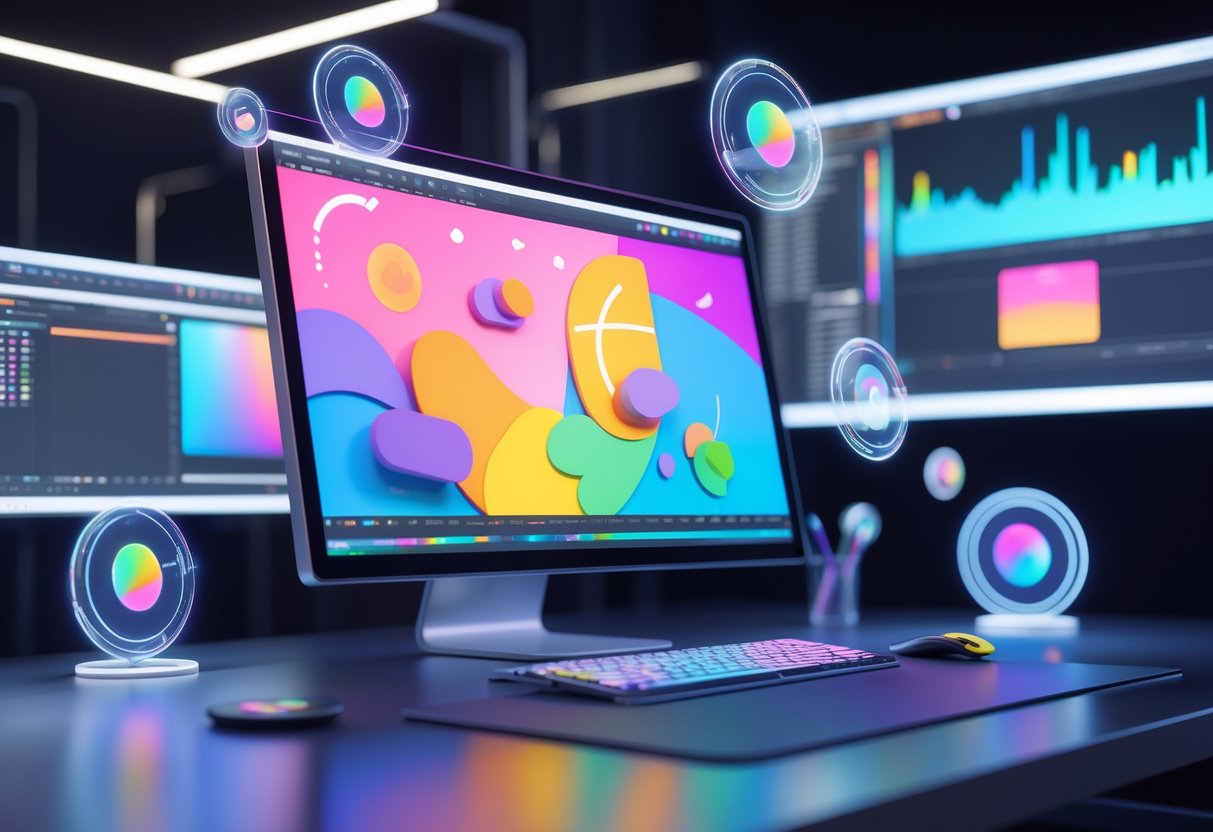
Visual extras can take a plain highlight video and turn it into something people remember. Stickers and text overlays add context and personality, and picture-in-picture lets you show more than one angle at once.
Incorporating Stickers and Text Overlays
Stickers inject personality and help highlight moments. Most editing apps have built-in sticker libraries—think emojis, shapes, or themed graphics.
Drop stickers in to spotlight big plays or flag key moments. Keep them in line with your video’s vibe, though.
Text overlays give viewers info like player names, scores, or timestamps. Pick fonts that fit your style—bold sans-serif is a solid choice for sports.
Use high-contrast colours for text. White with a black outline is hard to beat for readability. Leave text on screen for at least 3-4 seconds so people have time to read.
Best practices:
- Limit stickers to 2-3 per scene to avoid clutter
- Stick with consistent text sizing
- Place text in the lower third for a tidy look
- Test on mobile to make sure everything’s readable
Picture-in-Picture Techniques
Picture-in-picture lets you show multiple video sources at once—perfect for player reactions alongside gameplay. Esports highlights really benefit from this, especially when you want to show both the action and the celebration.
Position the smaller video in a corner where it won’t cover anything important. Usually, the secondary footage should take up about a quarter of the screen.
Common uses:
- Player cam reactions during clutch moments
- Multiple angles of the same play
- Before/after comparisons
- Commentary overlays
Try to match quality and frame rate between both sources. Mix the audio so the main clip stands out but you still get the secondary sound when needed.
Technical tips:
- Match colour grading between both sources
- Use rounded corners for the overlay window
- Add a subtle drop shadow for depth
- Keep the overlay in the same spot throughout
Working with Video Templates
Video templates can save tons of time and keep your edits looking sharp. Canva has loads of sports and gaming templates made for highlight reels.
Templates come with animated text, transitions, and slots for your footage. They make it easy to keep things consistent and professional, even if you’re not a design pro.
Picking the right template:
- Match the template’s energy to your content
- Make sure colours work with your footage
- Look for templates with good text placement
- Check the aspect ratio fits your target platform
Templates are great for series or regular uploads where you want consistent branding. Tweak colours, fonts, and animations to fit your channel, but keep the structure for speed.
Customising templates:
- Swap out placeholder text for real info
- Adjust timing to fit your clips
- Change colours to match your brand or team
- Add your logo or watermark for a pro touch
Aspect Ratio and Exporting for Social Platforms
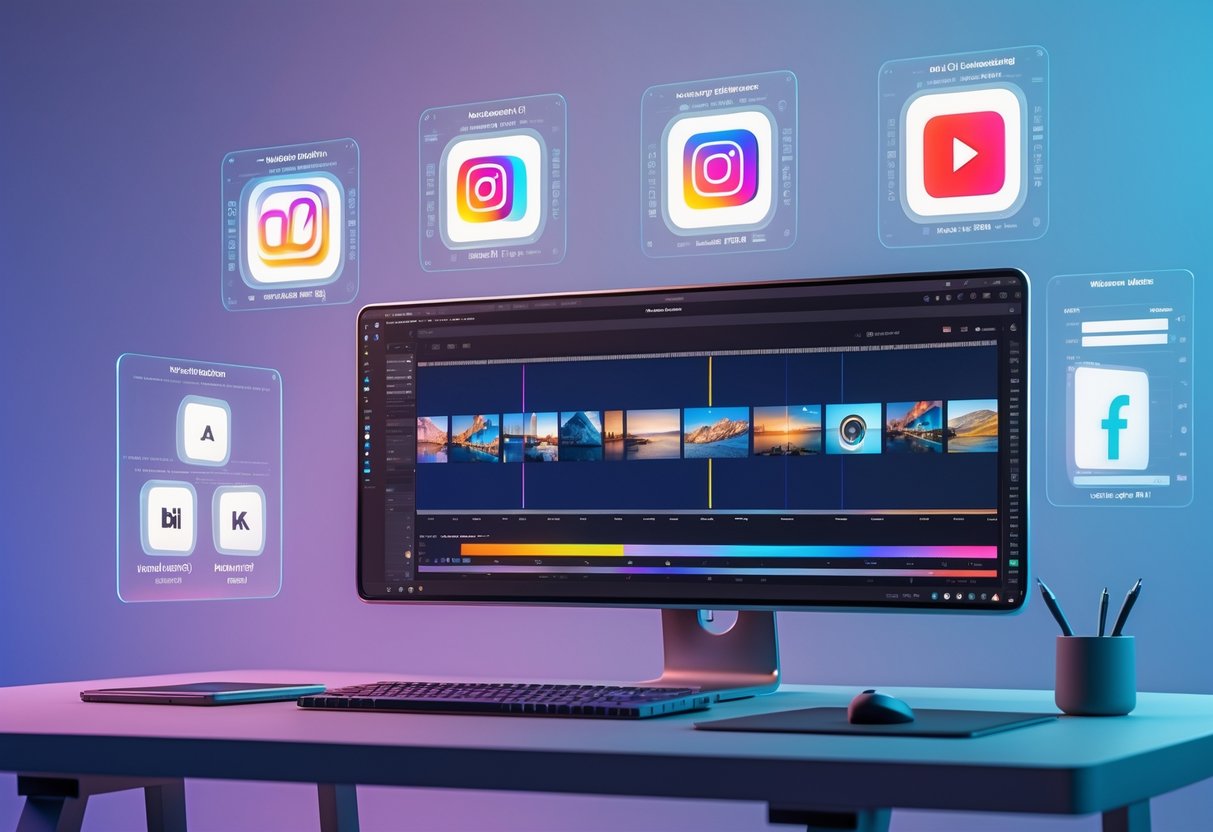
Getting aspect ratio right can make or break your video. Each platform wants something different, and exporting at the right quality means your highlights won’t get mangled by compression issues.
Selecting the Correct Aspect Ratio
9:16 (Vertical) shines on TikTok, Instagram Reels, and YouTube Shorts. It fills up the whole phone screen and really boosts viewer engagement.
16:9 (Horizontal) fits standard YouTube videos and Twitter posts. Most gaming footage comes in this ratio by default.
1:1 (Square) works well for Instagram feed posts and Facebook, taking up more space in feeds than horizontal videos.
Here’s what we usually recommend for each platform:
| Platform | Aspect Ratio | Resolution |
|---|---|---|
| TikTok | 9:16 | 1080×1920 |
| Instagram Reels | 9:16 | 1080×1920 |
| YouTube Shorts | 9:16 | 1080×1920 |
| Standard YouTube | 16:9 | 1920×1080 |
| Instagram Feed | 1:1 | 1080×1080 |
Quick tip: Start with 16:9 footage and crop to 9:16 for vertical platforms. You’ll save time compared to filming everything twice.
Customising for Instagram, TikTok, and YouTube
Instagram Reels need 1080×1920 resolution and videos under 90 seconds. Keep the action in the centre third—Instagram crops the edges sometimes.
TikTok sticks with 9:16 and prefers videos between 15-60 seconds. The algorithm loves content that keeps viewers watching till the end.
TikTok compresses videos a lot, so export at higher bitrates to keep things looking sharp. Avoid tiny text—it’ll just blur out after upload.
YouTube gives you more flexibility. Standard videos work at 1920×1080, and Shorts need 1080×1920. YouTube handles longer content better than other platforms.
For YouTube Shorts, keep the action in the centre. The app adds suggested videos at the bottom, which can cover up your content.
Platform-specific adjustments:
- Instagram: Add captions because most people watch without sound.
- TikTok: Throw in trending hashtags in your description.
- YouTube: Use custom thumbnails for standard videos.
Exporting in High Quality
Export settings can make or break your highlights. Bad compression ruins even the best clips.
Recommended export settings:
- Format: H.264 (MP4)
- Bitrate: 10-15 Mbps for 1080p
- Frame rate: Match your source footage (usually 30fps or 60fps)
- Audio: AAC, 128 kbps
Most editing software comes with social media presets. They’re easy for beginners, but usually over-compress your footage.
If you want crisp gaming highlights, bump the bitrate up by 20-30% over the default presets. Platforms compress uploads anyway, so starting with higher quality pays off.
File size considerations: Keep videos under 2GB for most platforms. TikTok limits you to 287MB, while YouTube lets you go much bigger.
Test your exports by uploading them to each platform and checking on your phone. What looks sharp on your computer might turn out blurry on mobile.
Popular Highlight Video Styles
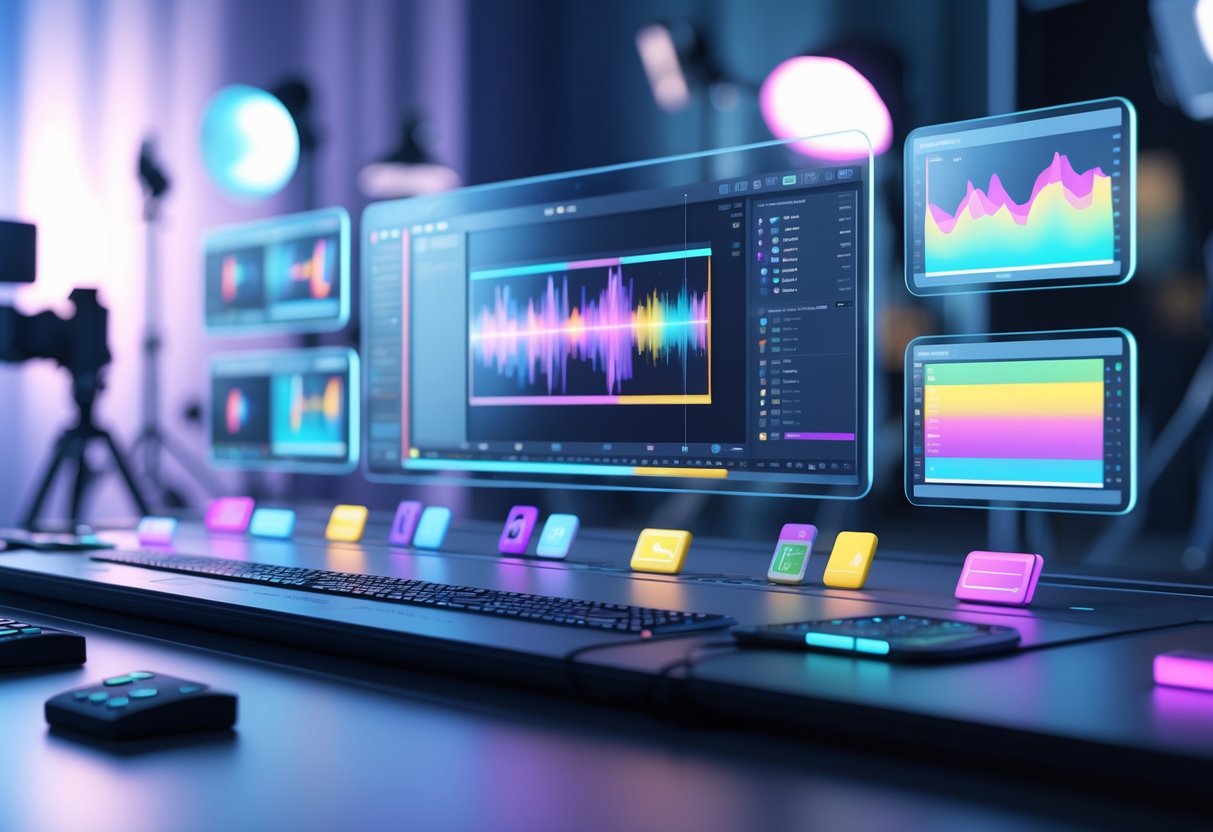
Different highlight video styles serve unique audiences and goals. Sports highlight videos capture the most exciting moments from matches and competitions. Event highlight videos preserve special occasions like weddings or conferences. Social media reels focus on bite-sized content built for engagement.
Sports Highlights
Sports highlight videos zero in on the most thrilling moments from matches, tournaments, and competitions. These clips usually show goals, winning plays, crazy saves, and game-changing moments.
Key elements include:
- Quick cuts between exciting moments
- Slow-motion replays of crucial plays
- Dynamic music matching the energy
- Score updates and team info
Sports highlights work best when they’re about 60-90 seconds long. Many include different camera angles of the same moment to show off every detail.
The most effective highlights start right away with the biggest moment. This grabs viewers before showing the build-up.
A lot of sports highlight videos use split-screen effects to show player reactions next to the action. Text overlays with player names, stats, and game info help people follow along.
Event Highlights
Event highlight videos capture the best moments from weddings, corporate events, festivals, or parties. These videos tell a story from start to finish, focusing on emotional peaks and memorable interactions.
Essential components include:
- Chronological storytelling from beginning to end
- Emotional moments like speeches or celebrations
- Candid reactions from attendees
- Key speakers or important guests
Event highlights usually run 2-4 minutes to allow for proper storytelling. They often mix natural sound bites with background music.
The best ones balance planned moments with spontaneous reactions. They show both wide shots of the venue and close-ups of people’s emotions.
These videos use softer transitions like fades and dissolves instead of quick cuts. Colour grading creates a consistent mood.
Social Media Reels
Social media reels aim to grab attention in the first few seconds and keep people watching. These highlights are built for Instagram, TikTok, and YouTube Shorts.
Critical features include:
- Vertical aspect ratio (9:16) for mobile
- Hook within 3 seconds to stop scrolling
- Trending audio or popular music
- Text overlays for silent viewing
Reels work best when they’re 15-30 seconds and move fast. The most successful reels use jump cuts, quick transitions, and visual effects to keep things lively.
Popular formats like “before and after,” countdowns, or tutorials get a lot of traction. Captions or text overlays help even if people watch with the sound off.
These videos get a boost from trending hashtags and posting during peak times. Many creators chop up longer highlights into multiple reels for different platforms.
Recommended Highlight Editing Tools
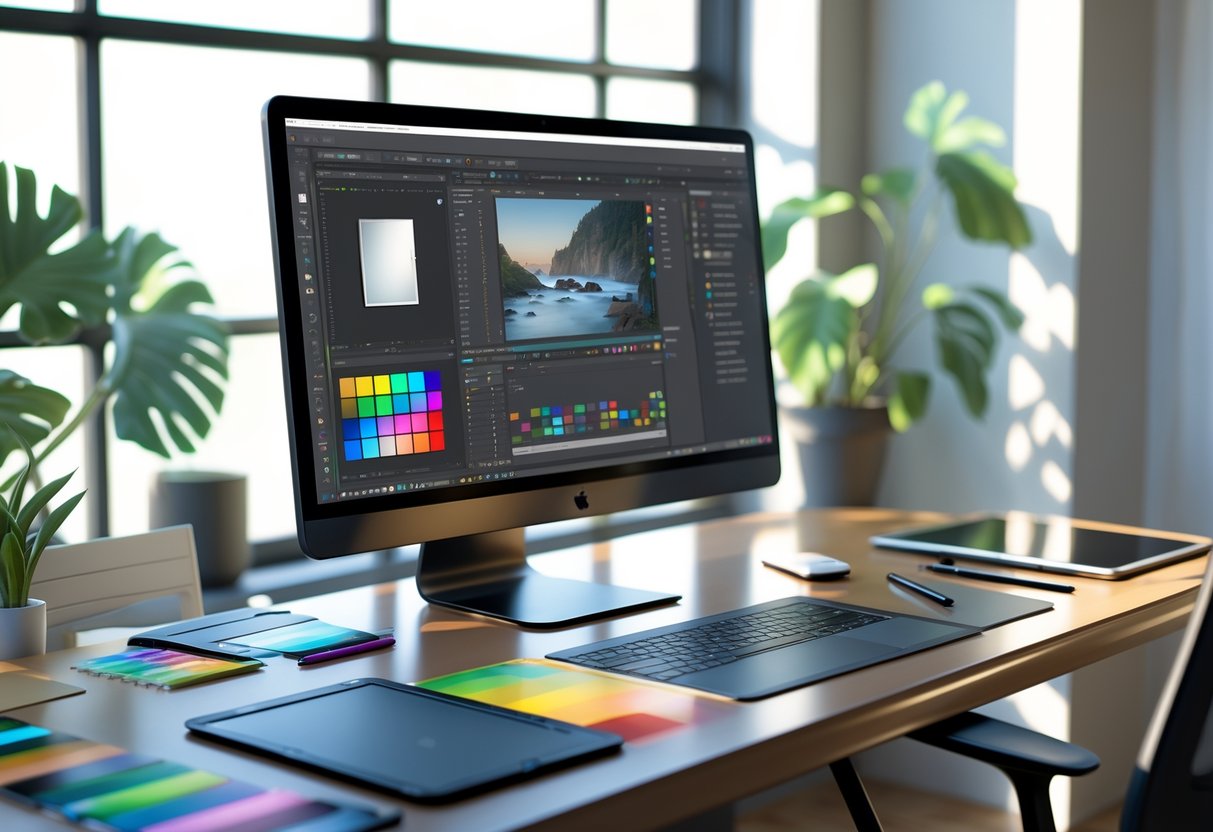
Editing highlights has gotten way easier thanks to powerful desktop software and web tools that automate the boring parts. The best tools mix AI-powered detection with pro templates so you can make polished highlights fast.
Overview of Leading Video Editing Software
Filmora really stands out as the most complete highlight editor I’ve tried. Its Smart Short Clips feature finds key moments and creates highlight reels for you.
The software has AI audio denoising to clean up background noise and can auto-generate subtitles. Motion tracking lets you keep an eye on specific players or objects.
Clipchamp keeps it simple and works great for fast social media highlights. It has templates for sports content and formats videos for Instagram Reels automatically.
InVideo does cloud-based editing, so you don’t need to download anything heavy. Teams can edit highlights on different devices or work together remotely.
If you want more control, traditional editors like Adobe Premiere Pro still offer the most options. But honestly, the learning curve is way steeper than with AI-powered tools.
Templates and Automation Features
Canva’s highlight templates come ready with sports themes and motion graphics. You can tweak colours, fonts, and transitions to match your team’s branding in minutes.
Their AI tools suggest highlight moments based on audio peaks and visual changes. This saves you from scrubbing through hours of footage.
FlexClip is all about template-driven editing, with over 1,000 pre-made highlight styles. Each template comes with music, transitions, and text animations that sync up with your clips.
Most modern tools now offer smart cropping for different aspect ratios. Upload once and the software spits out versions for YouTube (16:9), Instagram Stories (9:16), and TikTok at the same time.
Batch processing lets you apply the same editing style to multiple games or events. That keeps your branding consistent across all your highlights.
Best Platforms for Beginners
Clipchamp works right in your browser. Its drag-and-drop interface makes it possible to create basic highlights in about 15 minutes.
Canva has the easiest learning curve for total beginners. Their tutorials walk you through every step with clear visuals.
InVideo offers solid customer support through live chat and video guides. Their template library covers different sports and gaming content.
Filmora’s mobile app lets you make highlights straight from your phone footage. No need to move files between devices.
Most beginner-friendly platforms have free plans with watermarks. Paid plans usually start around £5-10 a month and remove branding while unlocking premium templates.
Frequently Asked Questions

These common questions cover the technical bits of highlight editing, from colour grading and audio sync to special effects. I’ve included practical steps you can try right away in your editor.
How can I apply colour grading to my video highlights?
Open your video editor’s colour panel and start with simple tweaks. Boost brightness and contrast first so your clips pop.
Most editors have colour wheels or sliders. Adjust shadows, midtones, and highlights separately for more control.
Try using the “vibrance” setting instead of saturation. It boosts colours without making skin look weird.
For gaming highlights, cooler tones usually look better. Nudge the temperature slider towards blue by 10-15%.
Copy your colour settings between clips to keep things consistent. Right-click your graded clip and paste those attributes to others.
What’s the best way to synchronise audio with my video highlights?
If your editor has automatic sync, use it. Drop your audio and video files onto the timeline and let the software do the work.
Look for sharp sounds like gunshots or explosions. These create clear spikes in the waveform—easy to line up by hand.
Zoom in on your timeline to get precise. Even a few frames off can create an annoying echo.
When recording gameplay separately, use the in-game audio as a reference track. Mute it once you’ve synced your commentary.
Always check sync with headphones. Speakers can hide small delays that viewers will definitely notice.
Could you guide me through adding transitions to my highlights?
Keep transitions short for gaming content. Stick to 0.2 to 0.5 seconds between clips.
Simple cuts usually work best. Fancy effects can distract from the action in highlight reels.
Try a quick fade to black between different matches or rounds. It shows a clear break for viewers.
For slow-motion moments, use a speed ramp transition. Ease into the slow part instead of changing speed instantly.
Don’t overdo it with transitions. Too many effects just make highlights feel messy.
What steps should I follow to add text overlays in highlight videos?
Pick simple fonts that are easy to read on phones. Arial or other sans-serif fonts are safe bets.
Make the text big enough for mobile screens. Always test your video on a phone before finishing up.
Use high-contrast colours with a bit of shadow or outline. White text with a black outline stands out on any background.
Keep text on screen for at least 2-3 seconds. People need time to read while watching the action.
Put text in the lower third of your video. That spot usually avoids covering up gameplay.
Can you show me how to adjust the speed of certain clips in a highlight montage?
Right-click your clip and look for “Speed” or “Time Remapping.” Most editors have this built-in.
For dramatic moments, slow clips down to 50-75% speed. Going slower than that can look choppy in gaming footage.
Speed up the boring parts to 150-200%. This keeps viewers from getting bored between highlights.
Use keyframes if you want variable speed effects. Start normal, slow down for the big moment, then speed up for the reaction.
Try to keep the audio pitch steady. Turn on “preserve pitch” so voices don’t sound weird at different speeds.
What are some popular effects to make my highlight clips stand out?
Try adding screen shake for those big moments, like when you score an elimination. Just don’t overdo it—too much shake gets old fast.
Zoom effects really help emphasize a critical play. Even a slight push-in can pull everyone’s eyes to the action.
Colour flash effects? They’re great for celebrating achievements. A quick white or gold flash can make special moments pop.
You might want to experiment with split-screen effects to show different angles of the same play. It’s especially cool when you want to highlight team coordination.
Motion blur gives fast movement a more dramatic touch. People often add it to quick scope shots or rapid moves for that cinematic vibe.

